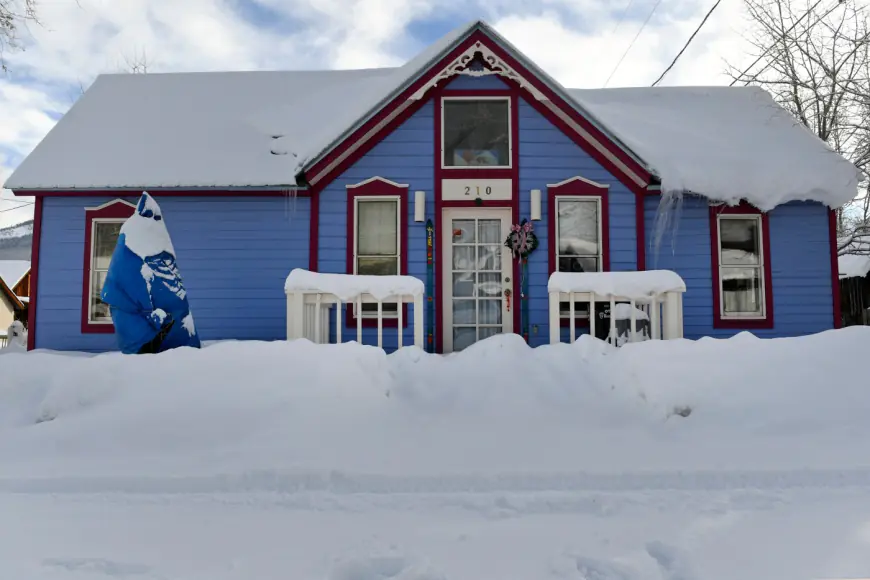Winter is on its way: How to prepare your Colorado home ahead of the first freeze
Denver's first freeze is expected to arrive Wednesday, so it’s time for homeowners to prepare their houses for winter.

Denver’s first freeze is on the horizon and it’s time for homeowners to prepare for winter.
The first freeze — when temperatures fall below 32 degrees and are expected to stay there for a “climatologically significant period of time” — typically arrives in Denver between late September and mid-October, according to the National Oceanic and Atmospheric Administration.
This year’s arrival of freezing temperatures could be the latest in more than a decade, National Weather Service meteorologists said. The latest 32-degree weather in the last ten years arrived in Denver on Oct. 28, 2015, followed closely by 2022’s freeze that arrived on Oct. 24. The latest the freeze has arrived since record-keeping began was on Nov. 15, 1944.
If 32-degree overnight lows arrive Wednesday in Denver as forecasted, they will break the record.
What to do for your home:
Check your furnace, HVAC System and thermostat.
The most important thing to do ahead of the first freeze is to make sure your heating system is ready to keep up with the winter cold, according to WireNut, a Colorado-based electrical, heating, cooling and plumbing company.
It’s time to unblock vents, clean out air ducts, schedule a furnace tune-up and check your home’s air filter, WireNut said.
Air filters should be replaced every one to two months, according to the Colorado home service company. Dirty air filters can restrict airflow and strain heating systems.
Coloradans should also make sure their thermostats are working and turning the furnace on at the correct temperatures so any maintenance that needs to be done can be scheduled before sub-zero temperatures arrive, WireNut said. If it takes a long time or does not reach the temperature set, there may be an issue with the HVAC system.
Clean the chimney and fireplace.
Debris can keep the chimney from properly ventilating and residue can catch fire inside the chimney, according to Colorado’s Energy Resource Center. If the chimney is structurally unsound, cracks also can leak carbon monoxide into the home.
Exposure to carbon monoxide, a colorless and odorless gas, is responsible for more than 100,000 trips to the emergency room, 14,000 hospitalizations and 400 deaths in the U.S. each year, according to the Centers for Disease Control and Prevention.
Homeowners should also check their carbon monoxide and smoke detectors before the first freeze. Carbon monoxide detectors need to be replaced every five years and should be installed near every sleeping area in the home, according to the CDC.
Check your insulation — especially in the attic and basement — and recaulk your windows and doors.
Improving the insulation of walls, crawl spaces, floors and heating ducts is one of the fastest and most cost-effective ways to reduce energy costs during winter months and can save Coloradans up to 10% on their monthly energy bill, according to Xcel Energy.
But don’t let the heat escape, the energy utility said. Before the first freeze moves in, Coloradans should have their home evaluated for leaky ducts, drafts around doors and windows, fireplace dampers and other areas where air might escape.
Income-qualified Coloradans can utilize the state energy office’s Weatherization Assistance Program to help protect their homes against the winter weather.
Weatherizing a home includes installing insulation, sealing air leaks to help maintain a comfortable indoor temperature and improve indoor air quality, replacing furnaces and installing storm windows, according to state officials.
Rotate your fans.
During winter months, ceiling fans should run clockwise so the warm air near the ceiling is forced down, according to Xcel Energy.
What to do for your garden and yard:
Clean your gutters.
Cleaning clogged gutters and downspouts prevents ice dams from forming, which can cause roof leaks, according to a Colorado gutter company.
To clean gutters well, Coloradans should remove big pieces of debris by hand, according to Gutters Inc. Then, flush out the rest using a garden hose or leaf blower.
Homeowners also should inspect gutters and downspouts for any cracks, rust or loose parts that could get worse under the weight of snow and ice, the company said. Minor problems can be fixed by hand with a waterproof sealant or screwdriver.
Remove hoses and drain sprinklers.
“Disconnect and drain hoses, shut off outdoor water sources and blow out your sprinkler system,” said the Schossow Group, a Colorado real estate company. Any leaks or damage should be repaired in the fall instead of the spring.
Simply turning off the water line to the sprinkler system isn’t enough, according to Bednarik, a Colorado landscaping and irrigation company. If the sprinklers aren’t blown out, there’s a chance that any remaining water inside them will freeze and expand, causing cracks and other damage to pipes, sprinkler heads, backflow preventers and more.
Trim tree branches, pull weeds and remove leaves and debris from your yard.
Prefreeze winter pruning will save trees from heavy winter snowfalls and can promote growth in the spring, according to Denver-based tree company Ross Tree. It can also help improve air circulation around trees, which leads to better-quality flowers, fruits and foliage.
Although weeds will die during the first freeze, their seeds will not, Colorado’s EcoTurf said. If weeds are covered by snow and kept safe throughout winter, they could multiply drastically in the spring.
Likewise, a warm spell during the winter months could cause the weeds to reawaken and bloom, Ecoturf said. It’s better to remove them entirely before the first frost and other winter weather moves in.
Get more Colorado news by signing up for our daily Your Morning Dozen email newsletter.
What's Your Reaction?








































































































